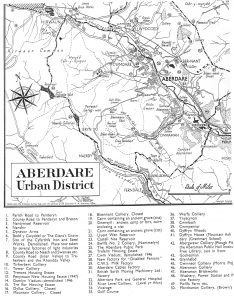“Sweet Bêr Dâr: Queen of the Valley”
A report on the monthly meeting of Resolfen History Society
This month’s speaker was the highly amusing and entertaining Huw Williams of Merthyr Tudful. Huw has visited us on many occasions and also held an adult education class in Resolven some years ago, an experience he recalls with affection. His topic this year was “Sweet Bêr Dâr”, a term which was used by its residents to describe Aberdare and its district. Its bilingual construction is indicative of the complex history of the valley and betrays far more of its history than the English version of “Queen of the Valley”. To others, including the residents of the Neath Valley, the residents were known as “Snakes”, its derivation unclear, though it may refer to strike breaking or be biblical in origin.
He described the valley at the beginning of the eighteenth century as being heavily wooded with oak trees. Indeed, a popular and probable myth in the Cynon Valley was that Nelson’s poop deck on the Victory at Trafalgar in 1805, came from Aberdare. Its geographical location as an open ended valley made migration easy for the residents of rural west Wales to migrate to the area as it was industrialised with iron smelting and coal mining in the early years of the eighteenth century. The migrants had to confront the challenge of a dangerous if comparatively well paid employment, but this was compensated by the lure of opportunity and housing which the pioneer mining valleys provided. They had to learn a new language of industrialised terms, though they and their owners remained Welsh speaking (the Cynon Valley has a distinctive Welsh accent in Welsh closer to that of Montgomeryshire which is now rarely heard, Ed.) The nature of the coal seams arranged in a syncline meant that the prized steam coal which fuelled the world became deeper and collieries such as Deep Navigation were operating over a mile underground. Recent scholarship has pointed out that much of the capital investment came from Bristol and thus the connection with the slave trade. Mr Williams pointed out that this should be viewed in the context of its time and not propelled into our more politically correct era. The prize at Aberdare was the 4’ seam, and this was eventually located by Thomas Powell at Dyffryn, so maximising a fortune and the founding of the famous Powell Duffryn Coal Company. The increase in production was dramatic.in the 1840s the production was around 12,000 tons which was largely used for smelting, but by the 1870s it stood at two million tons which was being exported around the world, fuelling the Royal Navy. Brunel himself had realised the importance of the Cynon Valley and between 1839 and 41 constructed the Taff Vale Railway which allowed the less efficient canals to be replaced by rail. This led to the development of Cardiff and Barry as major coal exporting ports.
Mr Williams, now turned to four unique features of the history of the Aberdare compared to the rest of south Wales. Firstly, the area was the first to have an iron bridge spanning a river. He discussed the claims of Abraham Darby at Ironbridge and other claimants on the Taff but was convinced that the first was on the Dare. Secondly, the Cynon Valley was the first valley to become exclusive to the production of coal. By 1870, the coal foundries had disappeared and coal mining dominated, twenty years before the Rhondda Valleys. This over reliance was remarked upon at the time as being very dangerous economically, since any hiccup in the coal trade would affect the area disproportionately. This became apparent when the still productive coal mines closed in the twentieth century.
Secondly, the Duffryn Colliery was the site of the first modern industrial dispute in 1843. Powell Duffryn dismissed 69 men and replaced them with another 200. This caused uproar, especially among the wives, who caused havoc by throwing pans and kettles at the new workers in favour of their partners. Cornish workers from the tin mines lasted one day when brought in to work, in the face of this militant sisterhood. Mr Williams stated that the role of women in the coalfield had always been prominent and that it was untrue that this had only appeared in the 1984/85 strike.
A third feature, was the fact that Aberdare was the scene of the first explosion and major coal disaster, when in August 1845 scores of men and boys as young as 10 years of age were killed by a combination of an explosion and carbon monoxide poisoning at Powell Duffryn. The Jury at the inquiry which was composed mostly of coal owners,met at the Boot Inn Aberdare and suggested that the cause was the poor ventilation of noxious gases at the colliery. This was later rectified by Nixon at the Deep Navigation colliery.
By 1851, the population of Aberdare stood at nearly 15,000, which though this would be eclipsed by Merthyr, gave it the fourth unique claim to be the first truly industrial community dominated by KingCoal.
Following a lengthy question and answer session, Trefor Jones thanked Mr Williams for a highly informative talk.
Trefor Jones

